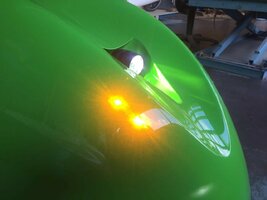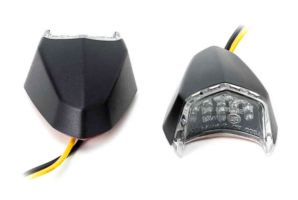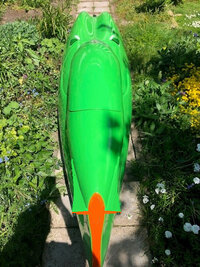- Beiträge
- 6.400
Install the app
How to install the app on iOS
Follow along with the video below to see how to install our site as a web app on your home screen.

Anmerkung: This feature currently requires accessing the site using the built-in Safari browser.
Du verwendest einen veralteten Browser. Es ist möglich, dass diese oder andere Websites nicht korrekt angezeigt werden.
Du solltest ein Upgrade durchführen oder einen alternativen Browser verwenden.
Du solltest ein Upgrade durchführen oder einen alternativen Browser verwenden.
Snoek von Velomobiel.nl (war: Quest RS)
- Ersteller Hoekie
- Erstellt am
-
- Schlagworte
- snoek velomobiel velomobil
- Beiträge
- 305
Hi @Kid Karacho , I think it's not complicated to add the same rear light system as the one used for the Alpha 7. A system à la DF could also be considered.
It's my own choice to have an easily detachable rear light system with clear information for the traffic. I will test this system for some time. With all the constructive feedbacks from the people of this forum plus some testing, the final version (or perhaps versions in case of multiples options) would please a broader majority.
Hi @gyps could you please alaborate on your concerns about the aerodynamics of the naca duct position and the front light ?
Greetings,
Clément
It's my own choice to have an easily detachable rear light system with clear information for the traffic. I will test this system for some time. With all the constructive feedbacks from the people of this forum plus some testing, the final version (or perhaps versions in case of multiples options) would please a broader majority.
Hi @gyps could you please alaborate on your concerns about the aerodynamics of the naca duct position and the front light ?
Greetings,
Clément
- Beiträge
- 1.751
@yirgacheff , das Snoek ist wunderschön geworden. Es ist super, dass ihr ein vm für kleinere und leichte Menschen entwickelt habt.
Bei der Blinkerbefestigung hinten habe ich Bedenken, dass ich sie beim Vorbeigehen abreiße. (Zu kleine Garage )Ästhetisch geht die Befestigung bestimmt noch schöner. Ich bin auch der Meinung, dass es wichtig ist, dass die Blinker gut zu sehen sind. Sie abzusetzen vom Chassis ist auch eine gute Idee. Wäre mir beim Bremslicht auch lieber (ähnlich wie bei den Autos)
)Ästhetisch geht die Befestigung bestimmt noch schöner. Ich bin auch der Meinung, dass es wichtig ist, dass die Blinker gut zu sehen sind. Sie abzusetzen vom Chassis ist auch eine gute Idee. Wäre mir beim Bremslicht auch lieber (ähnlich wie bei den Autos)
Vllt wäre etwas in der Art machbar?
2. wie werden bei deinem Snoek die Reflexstreifen aussehen und kann man diese in verschiedenen Farben ordern?
Bei der Blinkerbefestigung hinten habe ich Bedenken, dass ich sie beim Vorbeigehen abreiße. (Zu kleine Garage
Vllt wäre etwas in der Art machbar?
2. wie werden bei deinem Snoek die Reflexstreifen aussehen und kann man diese in verschiedenen Farben ordern?
Zuletzt bearbeitet:
velomobiel.nl
gewerblich
- Beiträge
- 30
the aluminium frame for rear lights will be made from carbon later, This looks nicer.
velomobiel.nl
gewerblich
- Beiträge
- 30
Wir finden Atto's nicht gut genug. Wenn Bremslicht an ist sind Blinker nicht sichtbar mehr. So wie Atto's auf Alpha seven montiert sind, kann Mann von Recht(hinten)die linker blinker nicht sehen, und anders um. Ein Atto tauschen wenn kaputt ist sehr sehr schwierig ,habe ich erfahren :-(
Und die können mal durchbrennen...
Deswegen haben wir Proton leuchten genommen mit separate Brems/Rücklicht auf diese weise montiert.
Und so montiert dass die immer gut zu sehen sind, und mann kann sehen ob linker oder rechter Blinker an ist, wass nicht bei Jede Velomobil so ist.
Grüße, Theo Velomobiel.nl
Und die können mal durchbrennen...
Deswegen haben wir Proton leuchten genommen mit separate Brems/Rücklicht auf diese weise montiert.
Und so montiert dass die immer gut zu sehen sind, und mann kann sehen ob linker oder rechter Blinker an ist, wass nicht bei Jede Velomobil so ist.
Grüße, Theo Velomobiel.nl
- Beiträge
- 4.296
Darüber kann man lange streiten, das möchte ich nicht. Nur so viel: 15.000 Km mit dem Alpha und 5.000 Km mit dem Milan mit Attos verliefen ohne Probleme. Ob ich gesehen werde, kann ich natürlich nicht sagen. Draufsicht im Dunklen ist sehr gut. Aber gerade beim Abbiegen finde ich einen gut eingestellten Spiegel viel wichtiger als den Blinker.Wir finden Atto's nicht gut genug.
velomobiel.nl
gewerblich
- Beiträge
- 30
Da sind 3 optionen für Spiegel auf Snoek. B&M spiegel mit kappe, Zefal Spiegel oder die Halbe "Schnelle leichte Renn" Spiegel die Yirgacheff hat.
B&M hat besten sicht.
B&M hat besten sicht.
- Beiträge
- 6.400
Sehen schöner aus als mein Blinkervorschlag, haben aber den Nachteil, dass von vorne Sonnenlicht einfallen kann und somit kaum Kontrastwechsel zwischen ein- und ausgeschaltet stattfindet.Vllt wäre etwas in der Art machbar?
- Beiträge
- 9.654
Na ja ... ohne CE darfst du in der EU nichts verkaufen und mit CE siehts dann halt so aus ... was du dann privat machst ...Ich kann kein "gefällt mir" geben wenn die Blinker hinten so eine Halterung haben
- Beiträge
- 1.751
Welche Blinker und Rücklichter richtig g...l wäre sind die von @Gear7Lover .
Das wäre meine erste Wahl
'gear7lover's neuer SL'
https://www.velomobilforum.de/forum/index.php?threads/gear7lovers-neuer-sl.54069/post-1042533
Das wäre meine erste Wahl
'gear7lover's neuer SL'
https://www.velomobilforum.de/forum/index.php?threads/gear7lovers-neuer-sl.54069/post-1042533
- Beiträge
- 9.654
Kein E-Zeichen ... dafür brauchst du als Hersteller dann eine Einzelabnahme.Welche Blinker und Rücklichter richtig g...l wäre sind die von @Gear7Lover .
Das wäre meine erste Wahl
Ich kann verstehen warum die Blinker so dran sind wie sie sind ... was der Käufer dann Zuhause macht, ist mir als Hersteller egal.
- Beiträge
- 987
It's rather an intuition but usually Naca ducts are positioned where the air flow is rather parallel to the vehicle.Hi @gyps could you please alaborate on your concerns about the aerodynamics of the naca duct position and the front light ?
If I look up the text on Naca ducts in Wikipedia:
it seems to me that the position you chose (i.e. where the air is maximally accelerated and has max speed according to cfd simulations) combined with the angle relative to the movement of the vehicle would counteract the principle of how the naca duct is supposed to work.Prior submerged inlet experiments showed poor pressure recovery due to the slow-moving boundary layer entering the inlet. This design is believed to work because the combination of the gentle ramp angle and the curvature profile of the walls creates counter-rotating vortices which deflect the boundary layer away from the inlet and draws in the faster moving air, while avoiding the form drag and flow separation that can occur with protruding scoop designs.
But again, I'm not an expert and this is just my naive intuition.
Cheers,
Alex
- Beiträge
- 2.252
Hat doch bisher keinen VM-Hersteller gestört, ich weiß nicht, warum Du darauf jetzt rumreitest. Laß die Hunde schlafen.ohne CE darfst du in der EU nichts verkaufen
- Beiträge
- 2.932
Don‘t sweat it.it seems to me that the position you chose (i.e. where the air is maximally accelerated and has max speed according to cfd simulations) combined with the angle relative to the movement of the vehicle would counteract the principle of how the naca duct is supposed to work.
Close to the surface the flow is aligned parallel to the surface pretty well.
The shallow angle they are talking about is the ramp angle of the inlet‘s „floor“ in relation to the surface of the body next to the inlet. If it is shallow enough you have very little flow separation in the inlet and thus very little energy losses.
The sharp „S“-shaped edge on either side of the inlet creates a vortex that helps scooping the air into it.
One important feature of this particular arrangement is that it does not disturb the flow on the body downstream of it. (As long as there is no light installed, that is.)
However, when the light protrudes out of the inlet and above of the body surface, it will create drag. But placed in a recess that the inlet is, is still better than without the recess.
I think the setup is a quite sensible compromise. You can easily switch between racing mode and everyday mode.
The chandelier type back lighting is prone to be damaged by people who can only see with their touching hands, though...
- Beiträge
- 9.654
Bisher gab es auch keine so große Produktion, wie sie jetzt in Ro steht.Hat doch bisher keinen VM-Hersteller gestört, ich weiß nicht, warum Du darauf jetzt rumreitest. Laß die Hunde schlafen.
Wenn ich es richtig sehe, entspricht hier die Beleuchtung zum größten Teil den Richtlinien und da es für Fahrräder mit mehr als 2 Rädern, keine min Sitzhöhe gibt, können die Hunde bei diesem VM ruhig aufwachen.
Gruß Jörg
- Beiträge
- 987
Das Prinzip des Naca Ducts ist mir schon klar.Don‘t sweat it.
Close to the surface the flow is aligned parallel to the surface pretty well.
The shallow angle they are talking about is the ramp angle of the inlet‘s „floor“ in relation to the surface of the body next to the inlet. If it is shallow enough you have very little flow separation in the inlet and thus very little energy losses.
The sharp „S“-shaped edge on either side of the inlet creates a vortex that helps scooping the air into it.
One important feature of this particular arrangement is that it does not disturb the flow on the body downstream of it. (As long as there is no light installed, that is.)
However, when the light protrudes out of the inlet and above of the body surface, it will create drag. But placed in a recess that the inlet is, is still better than without the recess.
I think the setup is a quite sensible compromise. You can easily switch between racing mode and everyday mode.
The chandelier type back lighting is prone to be damaged by people who can only see with their touching hands, though...
Lass es mich so formulieren: Senkrecht zur Fahrtrichtung eingebaut (also z.B. am Staudruckpunkt) wird das Naca Duct nicht die gewünschten Eigenschaften haben. Bei 45 Grad sicher auch nicht. Die Frage ist also, was ist der maximale Winkel, so dass es noch funktionieren kann und ist dieser hier nicht überschritten?
Ob dies die Aerdynamik des Fahrzeugs insgesamt stark beeinflusst wage ich zu bezweifeln, aber ich denke der maximale Winkel, so dass das Naca Duct noch als Naca Duct und nicht einfach als Loch in der Karosserie funktioniert ist, ist meinem Gefühl nach hier überschritten.

Gear7Lover
gewerblich
- Beiträge
- 14.105
Zusammen mit der komischen Karossenkante deren aerodynamischer Sinn sich auch nicht erschliesst sieht es nicht sehr Aero aus. Sunridermässig (sorry @JKL )
Bin überzeugt das funktioniert nicht im Sinne eines Naca-Duct. Möge der Anströmdruck die Strömung dahinter noch einmal anlegen, sonst ists ganz aus.
Bin überzeugt das funktioniert nicht im Sinne eines Naca-Duct. Möge der Anströmdruck die Strömung dahinter noch einmal anlegen, sonst ists ganz aus.
- Beiträge
- 2.932
Stimmt auch wieder. So, wie es da in der Rinne liegt, fragt man sich, ob das mit dem Wirbel anreißen da noch genauso gut funktioniert.Bin überzeugt das funktioniert nicht im Sinne eines Naca-Duct.
Da oben drauf ein tauschbarer Wartungslukendeckel wär praktisch zum probieren verschiedener Ausführungen.
- Beiträge
- 4.383
Zu den Blinkern:Here are a few pictures.
Wenn ich es machen müßte, würde es in die Richtung gehen:
Anhänge
- Beiträge
- 1.248
Ist das nicht wie beim Quest Konzept ? Wie hieß es gleich noch Mal 3.0 oder ?Zu den Blinkern:
Wenn ich es machen müßte, würde es in die Richtung gehen:
Davon habe ich auch schon lange nichts gehört.
Gefüllt wurde dies für das snoek nach hinten gestellt


